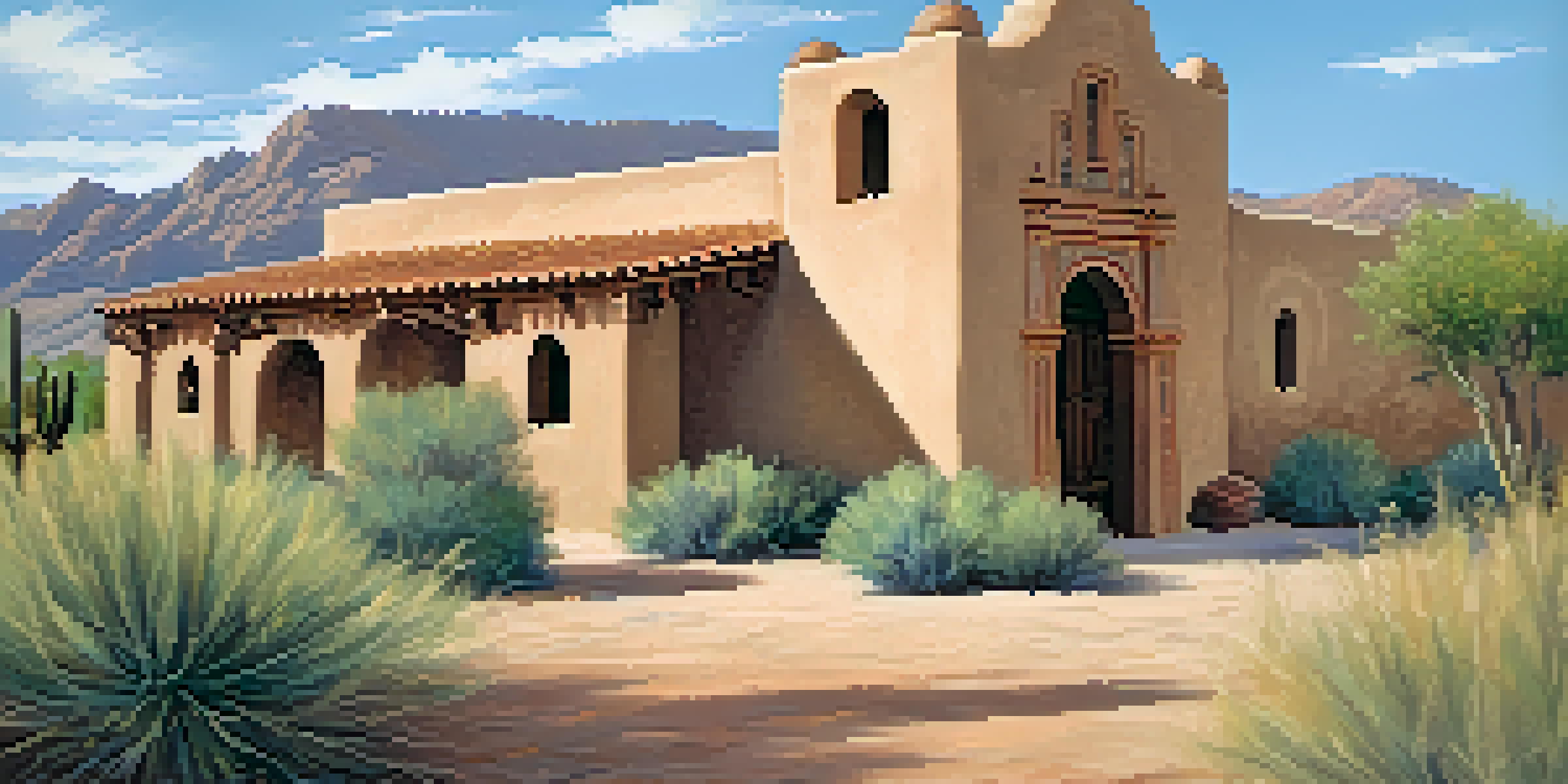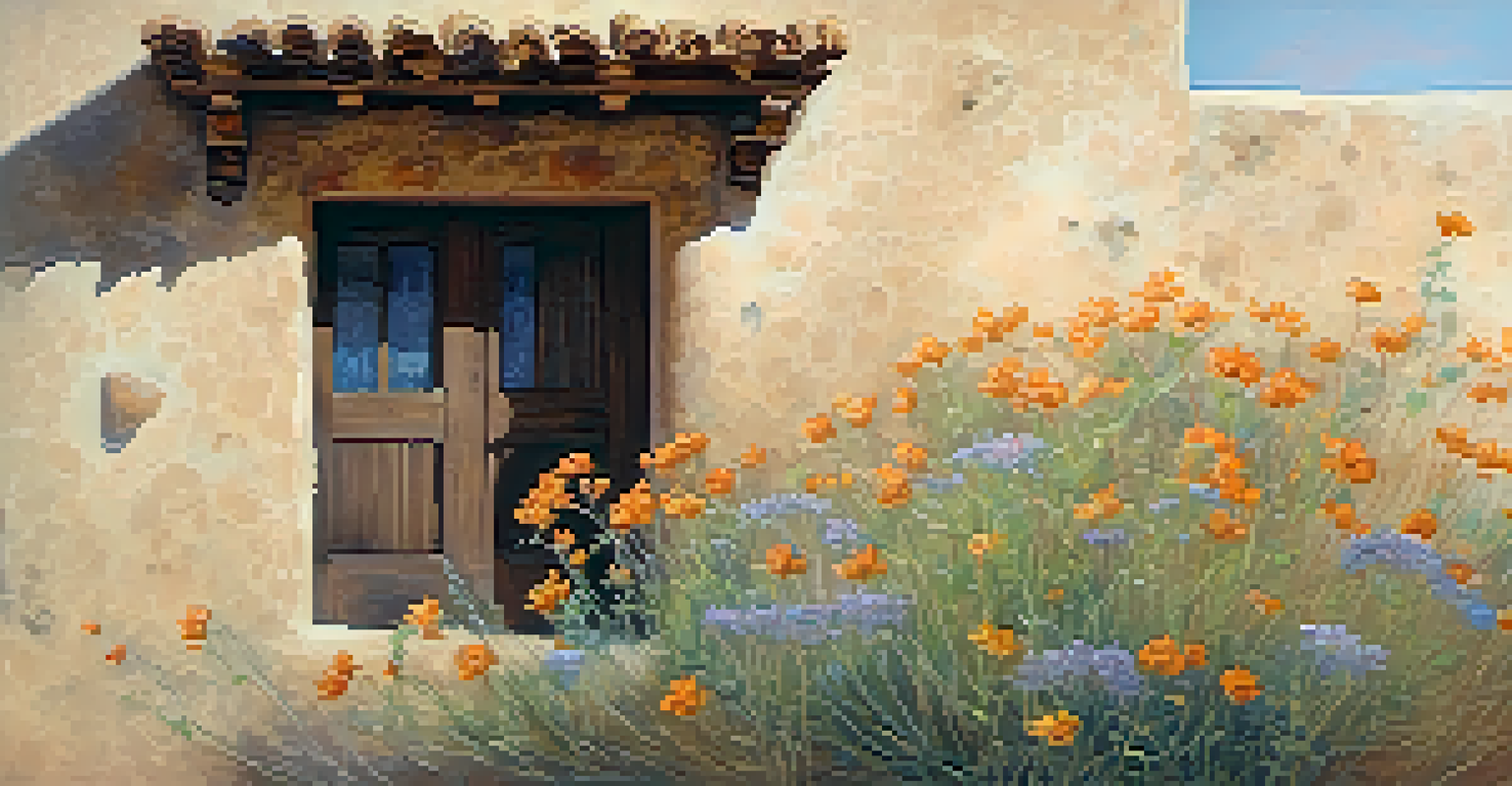Preserving Arizona's Spanish Missions: Cultural Heritage Sites

Understanding the Significance of Spanish Missions in Arizona
Arizona's Spanish missions are not just historic buildings; they are symbols of cultural exchange and adaptation. Established in the late 17th and early 18th centuries, these missions played a crucial role in the region's religious and cultural landscape. They served as centers for Christianity, agriculture, and education, influencing the local Indigenous populations and Spanish settlers alike.
The preservation of cultural heritage is not a luxury; it is a necessity for the survival of our identity.
These missions reflect a unique blend of Spanish colonial architecture and Native American traditions. Each site tells a story of resilience and adaptation, showcasing how different cultures interacted and shaped one another. By preserving these missions, we honor the rich tapestry of history that defines Arizona today.
Moreover, these sites serve as educational resources, offering insights into the past for future generations. They allow visitors to engage with history in a tangible way, fostering a deeper appreciation for the diverse cultural heritage of the region. Understanding their significance is the first step in advocating for their preservation.
The Role of Preservation Efforts in Cultural Heritage
Preservation efforts are essential for maintaining the integrity of Arizona's Spanish missions. These initiatives often involve a combination of restoration projects, educational programs, and community engagement. By focusing on preservation, we ensure that these historic sites can be enjoyed by future generations, allowing them to connect with their cultural heritage.

Organizations, both local and national, play a vital role in these preservation efforts. They collaborate with historians, archaeologists, and volunteers to restore and maintain the missions. This collective approach not only helps in physical restoration but also raises awareness about the importance of cultural heritage.
Cultural Significance of Missions
Arizona's Spanish missions symbolize cultural exchange and adaptation, showcasing the interactions between Indigenous populations and Spanish settlers.
Through public outreach and educational programs, these organizations engage the community, fostering a sense of ownership and pride in their local history. This engagement is crucial, as it promotes a culture of preservation that can sustain these sites for years to come. When communities value their heritage, they are more likely to support preservation initiatives.
Challenges Faced in Preserving Spanish Missions
While the importance of preserving Spanish missions is clear, the challenges are significant. Natural elements like weathering, erosion, and vegetation can take a toll on these structures, leading to deterioration. Additionally, funding for restoration projects can be limited, making it difficult to address urgent maintenance needs.
History is not a burden on the memory but an illumination of the soul.
Moreover, balancing modern development with preservation can create tension. As urban areas expand, there is often pressure to repurpose land that houses historical sites. This conflict can result in the loss of cultural heritage if not carefully managed, emphasizing the need for strategic planning and advocacy.
Community involvement is crucial in overcoming these challenges. By raising awareness and advocating for preservation, locals can help secure funding and support for missions. This grassroots effort can lead to sustainable solutions that honor both the past and the present.
Community Involvement in Preservation Initiatives
Community involvement is at the heart of successful preservation initiatives. Local residents often have the most profound connection to these sites, making their input invaluable. By participating in preservation efforts, community members can share their stories, traditions, and knowledge, enriching the narrative surrounding the missions.
Volunteers play a significant role in the upkeep of these historic sites. From organizing clean-up events to conducting educational tours, local residents help ensure that the missions are not only preserved but also celebrated. This hands-on involvement fosters a sense of pride and responsibility towards cultural heritage.
Importance of Preservation Efforts
Preservation initiatives are crucial for maintaining the integrity of these historic sites, involving community engagement and collaboration among various organizations.
Furthermore, partnerships between local organizations and schools can enhance educational outreach. By incorporating mission history into school curricula, younger generations can develop a deeper understanding of their heritage. This can lead to a more engaged community that values and supports preservation efforts.
The Impact of Tourism on Preservation Efforts
Tourism can be a double-edged sword for preservation efforts of Arizona's Spanish missions. On one hand, increased visitation can generate much-needed revenue for maintenance and restoration projects. Many missions rely on entrance fees and donations from tourists to fund their preservation efforts.
However, heavy foot traffic can also lead to wear and tear on these historic sites. It's essential to strike a balance between attracting visitors and protecting the integrity of the missions. Sustainable tourism practices, such as limiting visitor numbers and providing guided tours, can help mitigate potential damage.
Educating tourists about the importance of preservation is also key. When visitors understand the cultural significance of these sites, they are more likely to treat them with respect. By fostering a culture of responsible tourism, we can ensure that the missions remain preserved for future generations to explore and appreciate.
Educational Programs: Raising Awareness and Appreciation
Educational programs are vital for raising awareness about the importance of preserving Spanish missions. Through workshops, guided tours, and school programs, organizations can share the rich history and cultural significance of these sites. By engaging the community, they can foster a deeper appreciation for Arizona's heritage.
These programs often incorporate hands-on activities, allowing participants to connect with history in a meaningful way. For example, workshops on traditional crafts or cooking can provide insights into the daily lives of those who lived in and around the missions. This experiential learning not only enriches knowledge but also creates lasting memories.
Challenges in Mission Preservation
Natural deterioration, funding limitations, and modern development pressures pose significant challenges to preserving Arizona's Spanish missions.
Moreover, collaboration with local schools can ensure that younger generations learn about their heritage. When students participate in preservation efforts, they develop a sense of responsibility towards their cultural legacy. This education can inspire future advocates for preservation, ensuring the missions remain revered landmarks.
Future Prospects: Ensuring Long-term Preservation
Looking ahead, the long-term preservation of Arizona's Spanish missions will require sustained commitment from various stakeholders. It’s essential for local governments, organizations, and communities to collaborate on preservation strategies that address both immediate needs and future challenges. This unified approach can create a comprehensive preservation plan that benefits everyone.
Innovative funding solutions, such as grants and partnerships with private entities, can help secure the resources needed for ongoing maintenance. Additionally, leveraging technology for virtual tours and online education can broaden outreach and increase support for preservation efforts. By embracing modern solutions, we can enhance the visibility and relevance of these sites.

Ultimately, the future of Arizona's Spanish missions lies in the hands of the community. Through continued advocacy, education, and involvement, we can ensure that these cultural heritage sites are preserved for generations to come. Together, we can celebrate and protect the rich history that defines Arizona.